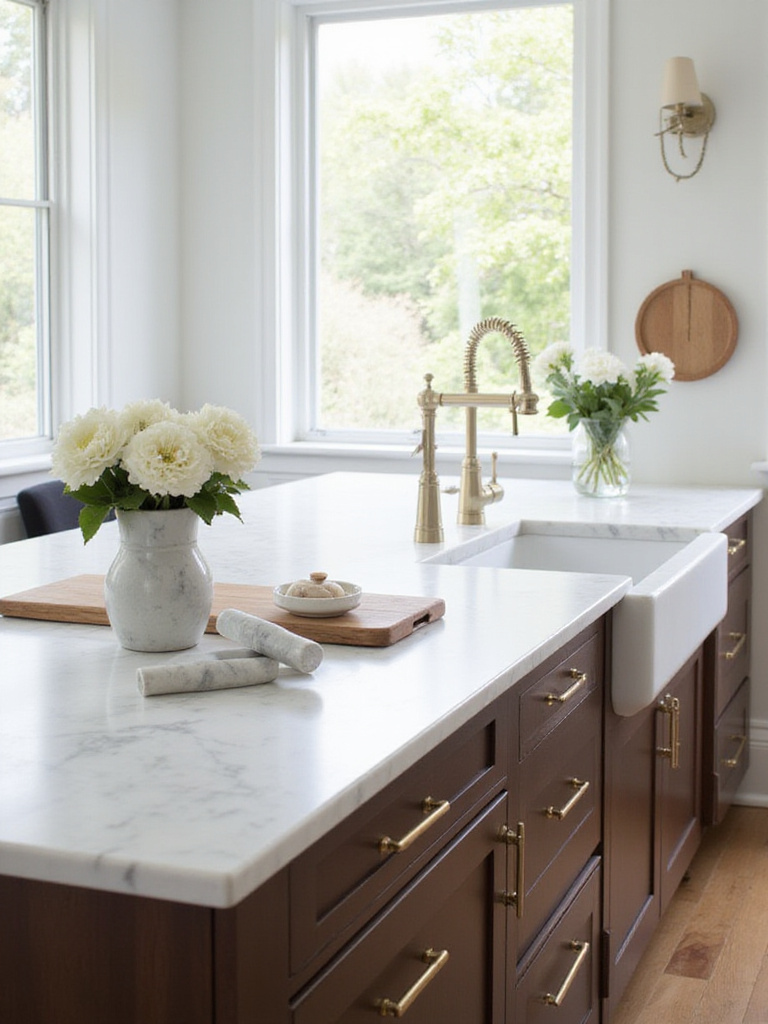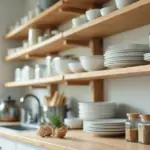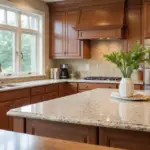Is your kitchen island feeling a bit…underwhelming? This central hub of your home deserves to be more than just a countertop. It’s a stage for style, a canvas for creativity, and a focal point ripe with decorating potential.
Imagine transforming your island from purely functional into a stunning design feature that reflects your personality. Ready to unlock the hidden beauty of your kitchen island? Let’s explore 20 brilliant decorating ideas that will revolutionize your space.
1. Illuminate Your Island: Stunning Pendant Light Ideas
Pendant lights are more than just illumination; they’re design statements that dramatically define your kitchen island’s style and ambiance. When selecting pendants, consider both practicalities and aesthetics. A common question is determining the correct size and number of lights for your space. As a general rule, add the length and width of your island in inches, convert to centimetres, and you’ll have a rough idea of the ideal diameter for a single pendant. For multiple pendants, aim for about 24-30 inches apart, centering them above the island.

The style of your pendants is equally crucial. Modern kitchens often shine with sleek, minimalist designs, while farmhouse kitchens call for rustic or industrial fixtures. Consider existing materials in your kitchen—metals, woods, colours—and select pendants that either complement or introduce a harmonious contrast.
Here’s where it gets interesting: pendant lighting doesn’t just illuminate your kitchen island decorating project—it transforms the entire mood of your space. A trio of oversized glass globes creates an airy feel, while industrial-style metal pendants add edgy character.
2. Warm Up Your Kitchen: The Beauty of Wood Countertops
While stone and quartz offer sleek sophistication, wood brings undeniable warmth and natural beauty to kitchen island decorating. Wood countertops infuse organic charm, creating a welcoming contrast to cooler kitchen materials. They introduce texture and character, instantly making your island a visual centerpiece. Beyond aesthetics, wood is surprisingly durable and, with proper care, can grace your kitchen for years.

Choosing the right wood species is vital for both durability and style. Hardwoods like maple, walnut, cherry, and oak are popular choices due to their resistance to scratches and dents. Butcher block, often made from hard maple, is a classic choice, especially practical if you use your island for food preparation. Think about the wood’s grain pattern and color to ensure it harmonizes with your kitchen’s design.
The game-changer happened as I incorporated a live edge wood countertop in a client’s minimalist kitchen. The organic, flowing edge transformed the space, adding warmth that balanced the sleek cabinetry perfectly. The natural element created a focal point that drew everyone into the heart of the home.
3. Hidden Gems: Clever Island Storage Solutions
A kitchen island represents valuable real estate, and maximizing its storage potential is key to a well-organized and efficient kitchen. Integrating storage into this space is a game-changer for decluttering countertops and keeping essential items within easy reach. This is especially beneficial in smaller kitchens, where every inch counts. Island storage helps maintain order and accessibility for frequently used kitchen tools and ingredients.

Beyond standard cabinets, there are innovative storage solutions worth exploring. Consider features like:
- Pull-out spice racks to keep seasonings organized near your cooking zone
- Knife block drawer inserts for safe and tidy cutlery storage
- Hidden appliance garages to discreetly conceal countertop appliances
- Open shelving for stylish cookbook or decorative item display
- Pull-out cutting boards with built-in waste disposal chutes
- Wine racks for sophisticated bottle storage
What complicates this aspect of kitchen island decorating is finding the perfect balance between accessibility and aesthetics. Plan your storage based on your cooking habits and the items you use most frequently, considering placement in relation to your stove, sink, and refrigerator.
4. Sit in Style: Chic Bar Stools to Elevate Your Island
Bar stools are essential for transforming your kitchen island into a casual dining area or social hub. Choosing the right stools involves several considerations, starting with height. Measure from the floor to the underside of your island countertop, typically allowing 10-12 inches between the seat and the countertop. Style should complement your kitchen’s overall design, whether modern, farmhouse, or industrial.

Comfort is also key, especially if you plan to spend extended time sitting at the island. Look for features like backrests, footrests, and cushioned seats. Material should be durable and easy to clean, considering your lifestyle and preferences. Finally, determine the number of stools based on your island’s length, allowing about 24-30 inches between each for comfortable movement.
“The right bar stool can transform your kitchen island from a prep space to a gathering spot where memories are made.” – Ava Sinclair-Patel
My experience went like this: I once mixed vintage metal stools with a sleek marble island for a client who wanted to blend industrial and luxury elements in their kitchen island decorating scheme. The contrast created a beautiful tension that made the space feel collected over time rather than purchased all at once.
5. Fresh & Fabulous: Displaying Produce with Style
Displaying fresh produce on your kitchen island is a simple yet impactful way to add color, life, and a healthy vibe to your kitchen. Beyond aesthetic appeal, it encourages healthier eating habits by making fruits and vegetables readily visible and accessible. It injects a pop of color and visual interest, creating a more vibrant and inviting atmosphere while freeing up valuable refrigerator space.

When choosing produce for display, prioritize items with longer shelf life at room temperature, such as:
- Apples, oranges, and citrus fruits
- Avocados (before ripening)
- Potatoes, onions, and garlic
- Bananas (though they ripen quickly)
- Decorative gourds or pumpkins (seasonal)
The heart of the matter is creating a visually appealing display by considering a variety of colors and textures. Try using tiered fruit baskets to maximize vertical space and create dynamic visual interest. Choose containers that complement your kitchen’s style—wood for rustic spaces, metal for industrial kitchens, or ceramic for traditional designs.
6. Pop of Personality: Injecting Color with Accessories
Color is a powerful tool for transforming the mood and style of your kitchen island. Introducing color breaks up the potential monotony of a neutral kitchen, adds visual interest, and injects your personal style into the space. A touch of color brings warmth, vibrancy, and individuality to what might otherwise feel like a sterile environment. Colorful accessories are a relatively inexpensive and non-permanent way to refresh your kitchen’s aesthetic.

Choosing the right accessories to introduce color is key to achieving a balanced and stylish look. Focus on functional yet visually appealing items such as:
- Brightly colored canisters for utensils or spices
- Vibrant fruit bowls or serving trays
- Eye-catching cookbooks on decorative stands
- Colorful bar stools or cushions
- Patterned tea towels draped casually
- Small potted plants with colorful blooms or pots
Let me paint you a picture: in my recent kitchen island decorating project, I arranged a collection of hand-painted ceramic canisters in shades of turquoise and coral against a crisp white island. The effect was stunning—like jewelry for the kitchen that immediately drew the eye and created a focal point that tied into subtle color accents throughout the space.
7. Green Goodness: Bringing Life with Plants & Herbs
Plants and herbs not only add a decorative touch but also infuse your kitchen island with natural freshness and vitality. They introduce natural beauty, color, and texture, softening the often hard surfaces of a kitchen. Plants improve air quality by filtering toxins and increasing humidity. Herb gardens offer fresh cooking ingredients, encouraging healthier eating and saving on grocery costs. They also have a positive psychological impact, reducing stress and creating a more welcoming kitchen environment.

Selecting the right plants and herbs involves considering your kitchen’s environment. Sunny islands are perfect for herbs like basil, rosemary, thyme, oregano, and mint, as well as succulents. For lower-light conditions, opt for pothos, snake plants, ZZ plants, or peace lilies. Think about the mature size of the plant to ensure it fits comfortably on your island and consider incorporating edible flowers like nasturtiums for added beauty and culinary flair.
The missing piece is often how to display your greenery effectively. Create a tiered herb garden using a stylish stand or tray, showcasing different herbs in individual pots. This not only makes a beautiful display but also makes harvesting easier when cooking. Consider the amount of sunlight your kitchen receives before making your selections—south-facing windows typically provide the most light.
8. Utensil Nirvana: Stylish Holders for a Clutter-Free Island
Keeping utensils organized and accessible on your kitchen island is key to both functionality and aesthetics. Organizing utensils prevents clutter, maximizes valuable counter space for food preparation, and ensures that essential tools are readily available while cooking. A well-organized utensil area contributes to a more efficient cooking environment, making meal prep smoother and more enjoyable.

Choosing the right utensil holders involves considering several factors to ensure they’re both practical and stylish. Think about the style of your kitchen and select holders that complement your existing decor. Consider the number of utensils you need to store and choose holders large enough to accommodate them without overcrowding. Material is important; opt for durable and easy-to-clean options like stainless steel, ceramic, wood, or silicone.
It works something like this: group utensils by type (spatulas, spoons, whisks) within the holder for easy access. For a farmhouse-chic look in your kitchen island decorating scheme, use a collection of vintage crocks or canisters. The contrast of old and new creates visual interest while keeping functionality at the forefront.
9. Cookbook Chic: Decorating with Books for Inspiration
Cookbooks are not just recipe repositories; they can be stylish and personal decorative elements for your kitchen island. They bring warmth, personality, and a sense of lived-in comfort to the space. Their varied colors, sizes, and cover designs offer visual interest and can reflect your personal style and culinary interests. Plus, they’re functional decor, readily available for recipe inspiration whenever needed.

Styling cookbooks on your island allows for creative expression and can enhance the overall aesthetic. You can stack them horizontally to create tiered displays, using the stacks as pedestals for other decorative items. Alternatively, arrange them vertically, showcasing their spines for easy browsing and visual appeal. Consider grouping cookbooks by color, size, or culinary theme for a more organized and cohesive display.
The breakthrough came when I realized cookbooks could serve multiple purposes in kitchen island decorating. Creating a tiered display using cookbooks as risers for plants, small kitchen tools, or decorative bowls adds dimension and height to your island styling. Before styling, curate your collection—remove any duplicates or books you never use to keep the display streamlined and intentional.
10. Marble Magic: Adding Luxury with Stone Accents
Marble is synonymous with luxury and sophistication, and incorporating even subtle marble accents can elevate the style of your kitchen island. It instantly enhances the perceived value of your kitchen, introducing a sense of timeless elegance. Beyond its aesthetic appeal, marble is durable (though porous and requiring sealing), and its cool surface is ideal for pastry preparation. The unique veining patterns add visual interest and can beautifully complement other kitchen elements.

Marble’s versatility extends beyond countertops, offering numerous creative applications for island decor. Consider:
- A marble backsplash that extends partially down the island’s side
- Marble cutting boards or serving platters on display
- Marble canisters for storing utensils or ingredients
- A small marble mortar and pestle for functional decoration
- Marble coasters or a marble fruit bowl
- Marble-patterned textiles for a hint of the look without the cost
You might be wondering how to incorporate marble without a complete renovation. Display a curated collection of marble serving boards and cheese knives on a wooden shelf attached to the island. This creates a beautiful contrast of materials and adds functional luxury to your kitchen island decorating scheme.
11. Farmhouse Charm: Creating a Cozy Island with Rustic Decor
Farmhouse style brings warmth, comfort, and inviting simplicity to a kitchen. Key elements that translate well to kitchen island decorating include natural materials, vintage-inspired finds, and a comfortable, lived-in feel. This means incorporating wood (especially reclaimed or distressed), natural textures like woven baskets, vintage-inspired lighting such as pendant lights with Edison bulbs, and showcasing practical items like ceramic pitchers or wooden cutting boards as decorative elements.

Balancing rustic farmhouse elements with a modern kitchen design requires a thoughtful approach. The key is to introduce farmhouse elements strategically and with restraint. Start with a neutral base, like white cabinets and countertops, and then layer in rustic accents. Consider using reclaimed wood for the island countertop or adding a shiplap accent. Instead of a fully rustic island, incorporate smaller details such as vintage-inspired bar stools, a galvanized metal utensil holder, or antique cookbooks.
The stumbling block is often achieving authenticity without creating a theme park feel. Use reclaimed wood for the island countertop or a decorative accent wall on the island. Distress new wood furniture to create a rustic look by sanding the edges, applying a stain and then wiping it off, or using a crackle finish. The goal is to create a space that feels collected over time, not purchased from a catalog.
12. Less is More: Embracing Minimalism in Island Decor
In contrast to more ornate styles, minimalism emphasizes simplicity and functionality in kitchen island decorating. It creates a sense of calm and order, which is particularly beneficial in a busy kitchen. A decluttered island makes the space feel larger and more functional. It also highlights the island’s inherent beauty, allowing its architecture and materials to shine. Instead of being overshadowed by accessories, the countertop, cabinetry, and design details become the focal point.

Achieving a minimalist kitchen island aesthetic involves focusing on essential elements and removing excess. Key elements include a clean, uncluttered surface, a neutral color palette, and a focus on functional items that also serve as decorative accents. Think of a single, carefully chosen vase with a few stems of greenery, a sleek fruit bowl with a few perfectly ripe fruits, or a stack of beautifully bound cookbooks. Avoid unnecessary knick-knacks or purely decorative items.
The tricky part is creating interest without adding clutter. A single, large sculptural bowl as a centerpiece can make a powerful statement. Start by decluttering your entire island—remove everything and then selectively add back only the most essential and visually appealing items. This deliberate curation creates a sense of intentionality that elevates your kitchen island decorating approach.
13. Prep Like a Pro: Integrating Functional Elements
Kitchen islands are primarily functional spaces, and incorporating practical elements into the decor enhances their usability. Integrating cutting boards blends practicality with aesthetic appeal, transforming a potentially purely decorative space into a functional workstation. This saves valuable countertop space elsewhere in the kitchen and streamlines meal preparation. A thoughtfully chosen and displayed cutting board can also add a touch of rustic charm or modern sophistication.

Choosing the right cutting boards for both function and decor involves considering different materials and styles:
- End-grain cutting boards: Durable, self-healing, with intricate patterns
- Edge-grain boards: Good balance of durability and aesthetics, showcasing beautiful wood grain
- Butcher block boards: Substantial, professional look
- Decorative boards: Materials like slate or marble for serving or display
- Wood boards: Preferred for chopping due to knife-friendliness
What really matters here is how these functional elements become part of your overall kitchen island decorating strategy. Incorporate a built-in cutting board that slides out from the island countertop for extra workspace during meal prep. This clever integration maintains the clean lines of your design while adding functionality. To clean wooden cutting boards effectively, sprinkle with coarse salt and rub with half a lemon—let sit for a few minutes before rinsing and drying.
14. Mood Lighting Mastery: Setting the Ambiance
Lighting plays a crucial role in setting the mood of any space, and your kitchen island is no exception. Mood lighting transforms your island from a purely functional area into a focal point that sets the atmosphere for cooking, dining, and socializing. It allows you to adjust the lighting to suit different activities, creating a relaxing environment for casual meals, a bright space for food prep, or a warm setting for entertaining.

Various lighting types can be layered to create effective mood lighting around your island:
- Pendant lights: Provide focused task lighting and can be dimmed for a softer glow
- Under-cabinet lighting: Offers subtle, indirect illumination
- Recessed lighting: Provides general ambient light, especially with dimmer switches
- LED strip lighting: Installed under the island overhang or toe-kick for a subtle glow
- Decorative lamps: Small table lamps add a cozy, living-room feel
- Candles: Real or LED versions offer classic romantic ambiance
- Smart lighting: Allows for customizable color temperature and brightness
The surprising part is how dramatically lighting can transform your kitchen island decorating efforts with minimal investment. Install dimmable pendant lights over the island to adjust the brightness depending on the activity. The color temperature of light significantly affects mood—warmer tones (2700-3000K) create a cozy atmosphere, while cooler tones (4000-5000K) are more energizing and suitable for task lighting.
15. Texture Talk: Adding Warmth with Woven Decor
Texture is a vital element in interior design, often overlooked but crucial for creating a welcoming and visually rich space. Kitchens often feature hard, smooth surfaces like countertops, cabinets, and appliances. Baskets and woven decor introduce natural, tactile elements that soften the overall look and feel, creating a warmer, more inviting atmosphere. The varied weaves and materials break up monotony, adding complexity and visual appeal.

The variety of baskets and woven decor suitable for kitchen island decorating is extensive:
- Storage baskets for fruits, vegetables, linens, or cookbooks
- Woven trays as stylish bases for displaying items
- Rattan or woven pendant lights to alter the mood and texture
- Woven placemats and coasters to add subtle texture
- Decorative woven bowls for potpourri or decorative objects
- Woven chair backs on bar stools for subtle texture
- Materials ranging from wicker and rattan to seagrass, jute, and bamboo
It’s kinda like adding a cozy jumper to your kitchen—these textural elements create warmth and dimension through contrast. Create a ‘fruit basket station’ on your island using different-sized woven baskets for holding fresh produce. Mix and match different types of woven materials and textures to create a layered and visually interesting look, perhaps pairing a seagrass basket with a jute placemat for a rich textural conversation.
16. Personal Touches: Showcasing Your Style
Beyond general decor, personalizing your kitchen island is what truly makes it feel like your own space. Personalizing transforms your island from a purely functional area into a reflection of your personality and lifestyle. It adds warmth, character, and makes your kitchen feel more inviting and lived-in. Incorporating items that hold meaning or showcase your interests creates a unique space that tells a story about who you are.

Selecting personal items for display requires a thoughtful approach to avoid clutter and maintain style. Consider:
- Cookbooks with visually appealing covers
- Small framed artwork or paintings that reflect your taste
- Curated collections like vintage teacups or pottery
- Elegant family photos in complementary frames
- Small herb gardens or stylish succulent arrangements
- Handmade items like artisan pottery or woven baskets
- Items related to hobbies, such as antique kitchen tools or favorite coffee beans
Before you raise an eyebrow at displaying personal items in a kitchen, remember that the most inviting spaces tell a story. Create a themed display based on a personal interest, such as a collection of vintage kitchen gadgets or your favorite coffee mugs. Start by selecting a few key items that you want to showcase and arrange them in different configurations until you find a layout that is visually appealing and balanced.
17. Sip & Style: Creating a Beverage Station
A beverage station on your kitchen island adds convenience and style for coffee lovers, tea enthusiasts, or cocktail aficionados. When designing a beverage station, consider your lifestyle and beverage preferences—coffee, tea, wine, or cocktails? Think about available space, plumbing needs (for a sink or ice maker), electrical outlets, and storage requirements. Functionality is paramount—plan for easy access and flow. Aesthetic considerations are also important; ensure the station complements your kitchen design.

Space can be a constraint, particularly on smaller islands, but clever solutions exist:
- Think vertically – use tiered stands or shelves to maximize counter space
- Consider built-in wine racks or narrow pull-out shelves for coffee pods
- Explore countertop beverage coolers instead of full-sized fridges
- A compact ice maker can be a good option
- Keep it minimal, displaying only essentials
- Wall-mounted organizers above the island can free up surface area
My breakthrough came when I created a coffee bar with a built-in espresso machine, grinder, and storage for beans and mugs for a client’s kitchen island decorating project. The key was installing a small sink with a filtered water faucet for easy access to clean water. This transformed their morning routine and created a natural gathering spot when entertaining. The station became both functional and a design feature that showcased their passion for quality coffee.
18. Color Contrast: Making Your Island Pop
If you want your kitchen island to be a true focal point, consider using bold color contrast. Color contrast immediately draws the eye and creates a strong focal point. A boldly colored island against a more neutral kitchen backdrop grabs attention and adds personality. It breaks up the potential monotony of a single-color kitchen, adding visual interest and depth. Color contrast allows you to express your style and create a kitchen that feels uniquely yours.

Numerous color combinations can create striking contrasts for kitchen island decorating:
- Navy blue islands paired with white cabinets for classic sophistication
- Emerald green islands with light gray cabinets for earthy elegance
- Cherry red islands with cream cabinets for bold energy
- Mustard yellow islands with dark gray cabinets for modern playfulness
- Black islands with white or light wood cabinets for dramatic effect
- Teal islands with warm white cabinets for a coastal vibe
The crucial element is preparation and commitment. Paint the island base a bold color and add contrasting hardware (e.g., brass pulls on a navy island). Properly prep the surface before painting—clean, sand, and prime to ensure the paint adheres properly and the finish is smooth and durable. This single change can transform your entire kitchen, making the island the star of your space.
19. Upward & Onward: Vertical Storage Solutions
In kitchens with islands, maximizing vertical space is a game-changer for organization and efficiency. Kitchen islands often have a limited footprint, making vertical storage a genius solution for maximizing functionality without sacrificing valuable counter space. By expanding storage upwards, you create room for cookbooks, spices, utensils, and small appliances, keeping the island surface clutter-free and visually appealing.

Creative vertical storage options can be seamlessly integrated into or around your kitchen island:
- Open shelving units mounted to the side of the island
- Tall, narrow pantry-style cabinets at the end of the island
- Pot racks suspended above the island
- Pegboards for hanging utensils
- Vertical magnetic knife strips
- Hanging glass racks for stemware
- Suspended herb gardens for fresh cooking ingredients
Here’s what happened when I installed a sleek, metal pot rack above a client’s island: it instantly freed up cabinet space while creating a professional chef’s kitchen aesthetic. The copper and stainless steel cookware became a beautiful design element in their kitchen island decorating scheme. Before installing any vertical storage, carefully measure the available space and plan the layout to ensure it doesn’t impede traffic flow or block access to other areas of the kitchen.
20. Festive Flair: Seasonal Decor to Refresh Your Island
Seasonal decorating is a wonderful way to keep your home feeling vibrant and in tune with the changing times, and your kitchen island is the perfect place to embrace this. Decorating seasonally injects personality and warmth into your kitchen, keeping it fresh and inviting throughout the year. It’s a simple way to celebrate holidays and changing seasons, boosting your mood and creating a festive atmosphere without a major renovation.

When choosing seasonal decor, practicality and safety are just as important as aesthetics:
- Consider your island’s size and layout
- Ensure decorations complement your existing kitchen style
- Avoid flammable materials near the stovetop
- Ensure decorations don’t obstruct walkways or food preparation
- Don’t sacrifice usable space for purely decorative items
- Create a cohesive theme for each season
Let that sink in for a moment—your kitchen island can be transformed throughout the year with minimal effort. For spring, try a vase of blooming branches, pastel-colored eggs in a decorative bowl, and a small herb garden in terracotta pots. Summer might feature bright citrus fruits and coastal elements, while autumn calls for warm tones with gourds and cinnamon sticks. Winter can showcase pinecones, evergreen sprigs, and subtle holiday accents.
Transform Your Kitchen Island, Transform Your Home
By embracing these 20 brilliant kitchen island decorating ideas, you can transform this central feature from a mere functional surface into a stunning centerpiece that reflects your style and elevates your entire kitchen. From illuminating pendants to warm wood, clever storage to stylish seating, and pops of color to seasonal flair, each idea offers a unique way to enhance your space.
The beauty of kitchen island decorating lies in its flexibility—you can implement changes gradually, experimenting with different elements until you find the perfect combination for your home and lifestyle. Whether you incorporate just one idea or several, your thoughtfully decorated island will become the heart of your home, a place where function meets beauty and everyday moments become special.
So take inspiration from these tips, unleash your creativity, and watch your kitchen island become a true testament to thoughtful design and personal expression—a space that not only works beautifully but feels uniquely yours.






